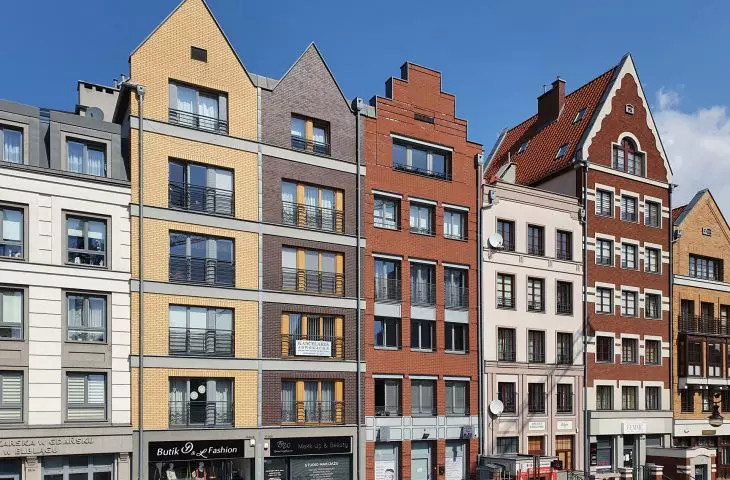A story about the reconstruction of Elblag from the 05|2021 issue of A&B
I remember the uniqueness of my childhood. It involved what was probably the world's largest backyard, where I used to go out to play with kids from the neighborhood.
"are we going to the ruins?"
I was born in 1973 in Elblag. I lived on Squires Street, in the strict center-non-center of the city. Elblag was kind of strange, although as a toddler I was obviously not aware of it. Our neighborhood consisted of brick, four-story, tile-roofed apartment houses built after the war; further on, the city's ubiquitous big slabs began. The city developed eastward, more large prefabricated districts were built, led by the Zawada and Nad Jarem neighborhoods.
I lived in a neighborhood that would normally be in the heart of the city, but in the Elblag peculiarity our house stood on the edge of the city. Further away, beyond today's Rycerska Street, stretched all the way to the horizon... a sea of rubble. Or rather, a sea of foundations. It was a remnant of the Old Town of Elblag, completely demolished during World War II.
For us - kids - it was simply a fantastic, colossal playground, a maze in which we could endlessly play shooting, hide-and-seek, set up bases, well, and rummage in the ground, hoping to find some post-German ironwork, and sometimes things much, much older... The slogan "we're going to the ruins" was synonymous with adventure.
Tenement houses on St. Spirit Street
photo: Adrian Sajko
polish metamorphoses
In those days we didn't ask ourselves "why," "how," or "what should be done about it." We chased around the ruins, had a great time and that was it.
Many, many years passed. For most of my adult professional life I have been involved in marketing places. My work for the past almost thirty years has consisted of creating brand strategies for places: cities and regions. I have written more than eighty of them to date - for localities and provinces across Poland. These are important documents, having, as it turns out years later, a huge impact on reality. Well conceived and correctly implemented, such strategies are documents that determine investments, changes in the fabric of cities, reforms of urban spaces, important initiatives for social development. Traveling around Poland, I observe with fascination the processes that shape cities and regions. I look at them, on the one hand, as an enthusiast of places and local communities, a devourer of the phenomenon of genius loci, an admirer of history shaping the present we inhabit. On the other hand - as a professional, a professional who has co-created ideas for the future of Sopot, Warsaw, Krakow, Kolobrzeg, the entire Upper and Lower Silesia, Malopolska and many more places.
A fragment of the entrance to a tenement house on Św. Ducha Street
photo: Adrian Sajko
The processes shaping the development of these places are particularly interesting precisely in our country. Not everywhere in Europe can we find such phenomena as the Recovered Territories. Cities and regions settled anew after the war, after the indigenous population was chased out of them. Often destroyed. Sometimes destroyed spectacularly, such as Gdańsk, Wrocław, Lwówek Śląski, Kołobrzeg or just Elbląg. These cities - each differently - somehow rose from the rubble after the war.
These metamorphoses took place differently under the communist regime, while they gained a completely different quality, pace and momentum in democratic Poland, and especially in European, EU Poland. And it's not at all the case that newer is always better; in communist Poland, for example, high-end urban planning was cultivated, while in capitalist Poland, on the other hand, developer development often rules.
For these reasons, Polish urban metamorphoses are truly amazing. Different, better and worse, more or less chaotic, prettier and uglier. But there are always some, extremely intriguing when we try to reconstruct their logic, their often turbulent fates. Tracing these stories is my profession, but also my passion. That's why I described the fate of "demolished cities" in a separate article, which I invite you to read in Open Eyes Magazine 6, published in November 2021. There you will find amazing stories of the rebuilding of the cities already mentioned, including the unique case of Jaslo, and, particularly interesting in the context of Elblag, the example of Glogow, a city that also decided to follow the path of retroversion, which we are writing about with vigor in A&B today. Glogow, however, realized its retroversy quite differently than Elblag did. How - we tell you in Open Eyes Magazine. And we won't forget there the demolished and rebuilt Warsaw - the largest reconstruction in this part of the world.
bird's eye view of the frontage of Rybacka Street (closer to the river)
photo: © Zakład Usług Budowlanych "MYTYCH"
retroversy
But it's time to return to Elblag and its retroversy - our main topic.
The ruins, or rather the foundations of Elblag's Old Town, were a boundless void, absurdly disturbing. In the middle stood alone the huge St. Nicholas Cathedral, one of the largest Gothic churches of medieval Europe. A few surviving tenement houses stood shyly beside it. All around were acres of flat ruins.
Let's go back a few hundred years now: in the second half of the 16th century, Elblag is the Polish window to the world. It replaces in this role the overly greedy and not entirely loyal to the Polish-Lithuanian Commonwealth Gdansk. King Stefan Batory directs all the maritime exports of the then largest country in Europe to the port of Elblag. The city grows rapidly in power, expands rapidly, and its golden age continues. Gdansk, meanwhile, is in severe decline.
It is in Elblag that the first Polish warship - the galleon Dragon - is built, the first high school in Poland opens, the Elblag Library (outstanding to this day) is established, the English launch the Eastland Company here monopolizing British trade with this part of the world. It is in Elblag that Shakespeare's play is staged in Poland for the first time. The city is a great port with shipyards, Granary Island, the Old and New Town densely built up with hundreds of magnificent townhouses.
In the 17th century, the city sadly declines, the waterway to the port becomes silted up, and the commercial hegemony gradually returns to Gdansk. Despite the marginalization, the magnificent buildings remain in place. Until the arrival of the Red Army. Elblag was - to its misfortune - a German "Festung," a fortress. However, it lay on the sidelines of the main direction of the Russian advance towards Berlin. There was no need to capture it by storm. So the Soviet artillery was able to get on with the methodical demolition of the entire city center without haste. Ninety-eight percent of the buildings in the old center disappeared from the face of the earth.
Elblag had no luck and after the war. It was considered more important to rebuild the old towns of Gdansk, Warsaw and Wroclaw. Elblag's tenements, or rather what was left of them, were demolished, and the bricks obtained were used to rebuild Gdansk and Warsaw precisely. Here all that remained was a sea of sad foundations. The city never made it to the list of government priorities - decades passed, and the foundations stood as they stood. At the time, there was an intriguing discussion - fortunately for the city, as it turns out: "What to do with this historic center of Elblag?". Urban planners, architects, historians wondered; ideas abounded. Reconstructive reconstruction (such as in Gdansk and Warsaw) was considered, and there were also thoughts of simply building up the entire space with blocks of large plates (as was done, for example, in Kolobrzeg).
And finally there was the idea of retroversion, i.e. rebuilding the city on the basis of respect for the historical grid of streets and characters, the size of the facades of former tenements, but with the assumption that the architect will have the right to enter into a discussion with the past. The reconstructed tenement is not to be a copy of the demolished one - it is to be a postmodern interpretation of it, a kind of variation on the previous building. This approach, by the way, turned out to be in line with UNESCO recommendations in similar situations. A once-destroyed structure should not be artificially recreated, repeated, copied, in place of the history-soaked and real walls, putting up a deceptively similar mock-up. Architecture has the right to live, change, adapt to reality, go with the times, it should be authentic. I agree with this approach, I sense the falseness of mock-ups, replicas, copies.
The boards from the exhibition Nówka-Starówka, from left:
- a view of the Old Town before World War II; a reconstruction of the 14th-15th century plan of the Old Town.
- A view of the Old Town in 2020; a 2018 plan of the Old Town, the most important monuments
Photo: © Archive of the Elbląg UM
continued on next page


































